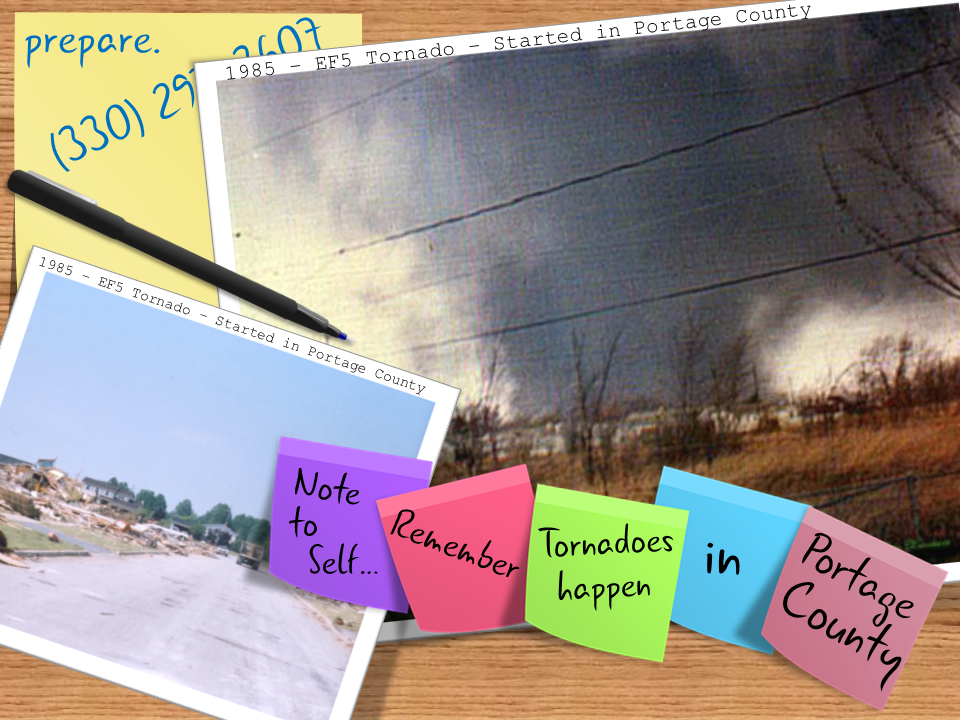Portage County Tornado History

Tornadoes can and do happen in Portage County!
About 1,200 tornadoes hit the United States every year and every state is at risk. Most tornadoes in the United States occur east of the Rocky Mountains with concentrations in the central and southern plains, the Gulf Coast and Florida. Tornadoes can strike in any season, but occur most often in the spring and summer months. They can occur at all hours of the day and night, but are most likely to occur between 3 p.m. and 9 p.m. Only a handful of EF-5 tornadoes have impacted Ohio. One of them began Portage County in 1985, staying on the ground for 45 miles until reaching Wheatland, PA and leaving nearly 400 homes destroyed in it's wake.
Before a Tornado
- Identify safe rooms built to FEMA criteria or ICC500 storm shelters or other potential protective locations in sturdy buildings near your home, work, and other locations you frequent so you have a plan for where you will go quickly for safety when there is a Warning or an approaching tornado.
- For schools, malls, and other buildings with long-span roofs or open space plans, or many occupants, ask the building manager to identify the best available refuge.
- Build an emergency kit and make a family communications plan.
- Listen to NOAA Weather Radio or to commercial radio or television newscasts for the latest information. In any emergency, always listen to the instructions given by local emergency management officials.
- Be alert to changing weather conditions. Look for approaching storms.
- Look for the following danger signs:
- Dark, often greenish sky
- Large hail
- A large, dark, low-lying cloud (particularly if rotating)
- Loud roar, similar to a freight train.
- If you see approaching storms or any of the danger signs, be prepared to take shelter immediately.
Know the Terms
Familiarize yourself with these terms to help identify a tornado hazard:
- Tornado Watch - Tornadoes are possible. When there is a Watch, move to be near enough to a shelter or sturdy building to be able to get there quickly in a few minutes if there is a Warning or if you see signs of a tornado approaching. Remain alert for approaching storms. Watch the sky and stay tuned to NOAA Weather Radio, commercial radio or television for information.
- Tornado Warning - A tornado has been sighted or indicated by weather radar. Take shelter immediately.
During a Tornado
If you are under a tornado warning, seek shelter immediately! Most injuries associated with high winds are from flying debris, so remember to protect your head.
If you are in school, nursing home, hospital, factory, shopping center, high-rise building pre-identified best available refuge then:
- Go to a pre-designated area such as a safe room built to FEMA criteria, or a small interior windowless room on the lowest level, below ground in a basement, or storm cellar, is best. (closet, interior hallway) away from corners, windows, doors, and outside walls. Put as many walls as possible between you and the outside. Get under a sturdy table and cover your head and neck with your arms and cover your body as best you can e.g., with a heavy coat or blankets, pillows. .
- In a high-rise building, go to a small interior room or hallway on the lowest floor possible.
- Do not open windows.
- A sturdy structure (e.g. residence, small building) , school, nursing home, hospital, factory, shopping center, high-rise building)
A manufactured home or office then:
- Get out immediately and go to a pre-identified location such as the lowest floor of a sturdy, nearby building or a storm shelter. Mobile homes, even if tied down, do not offer protection from tornadoes.
The outside with no shelter then:
- If you are not in a sturdy building, there is no single research-based recommendation for what last-resort action to take because many factors can affect your decision. Possible actions include:
- Immediately get into a vehicle, buckle your seat belt and try to drive to the closest sturdy shelter. If your vehicle is hit by flying debris while you are driving, pull over and park.
- Take cover in a stationary vehicle. Put the seat belt on and cover your head with your arms and a blanket, coat or other cushion if possible.
In all situations:
- Do not get under an overpass or bridge. You are safer in a low, flat location.
- Never try to outrun a tornado in urban or congested areas in a car or truck. Instead, leave the vehicle immediately for protection in a sturdy building. .
- Outdoor areas are not protected from flying debris. Flying debris from tornadoes causes most fatalities and injuries.
After a Tornado
- If you are trapped, do not move about or kick up dust. Tap on a pipe or wall or use a whistle, if you have one, so that rescuers can locate you.
- Listen to local officials for updates and instructions.
- Check-in with family and friends by texting or using social media.
- Watch out for debris and downed power lines.
- Stay out of damaged buildings and homes until local authorities indicate it is safe.
- Use extreme caution during post-disaster clean-up of buildings and around debris. Do not attempt to remove heavy debris by yourself. Wear protective clothing, including a long-sleeved shirt, long pants, work gloves, and sturdy, thick-soled shoes during clean-up.
- Photograph the damage to your property in order to assist in filing an insurance claim.
- Do what you can to prevent further damage to your property, (e.g., putting a tarp on a damaged roof), as insurance may not cover additional damage that occurs after the storm.
- If your home is without power, use flashlights or battery-powered lanterns rather than candles to prevent accidental fires.

